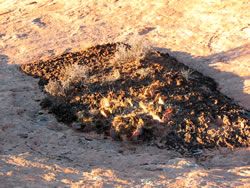Hiking Happenings June 2005 Staff of Life June is the time of year when Indian rice grass is at its most beautiful and fruitful. It’s a classic Western bunch grass - a perennial about two feet tall that grows as a distinct individual, rather than joining with its neighbors to create a sod cover. While it doesn’t form sod, it can be a prolific, even dominant species in some areas. In late June, rice grass seeds ripen. Each black seed, about half the size of a grain of rice, has the distinctive cereal flavor. There are typically scores of seeds on each plant’s many graceful stems. To gather seeds, run the stems through your fingers as you walk along. It’s easy to see how Indians could have stuffed baskets full. Not only did rice grass provide food for the ancient peoples, it was also primary forage for over a million big horn sheep, not to mention the innumerable deer, elk, bear, mice, birds, and bunnies that have lived here since the end of the last Ice Age. On the Colorado Plateau, Indian rice grass was the staff of life for over ten thousand years.
There
were places in the Four Corners region where the hay
from these plants was inches thick - a mother lode of
hay. And, when the European impulse arrived in the 1870’s, this sealed
its fate. Colorado’s silver bonanza drew tens of
thousands of miners; hungry miners who fed on cattle fattened
on rice grass. By the 1890’s, southern Utah’s
rice grass colonies were no longer sufficient to sustain
the herds. That’s why many ranchers began raising
sheep. Cattle nibble their feed to ground level. Sheep
will tear the plants out by the roots, an especially bad
idea in a place that gets a mere eight inches of rain a
year. To make a bad situation worse, cheat grass arrived
at the same time. It’s an annual plant from the steppes
of western Asia that is not nearly as attractive to grazers
as rice grass. And it competes effectively for the same
food, water, and light as the native plants. It was a one-two
punch. Eighty centuries of rice grass culture on the Colorado
Plateau hit the deck in twenty years.
|

